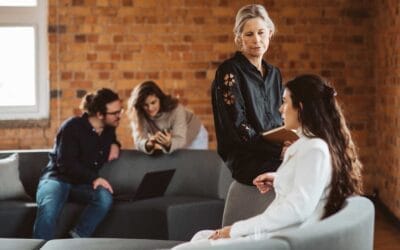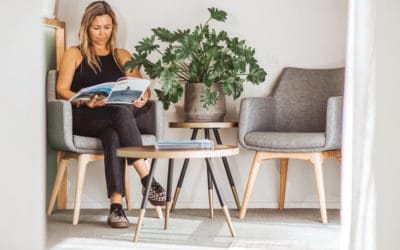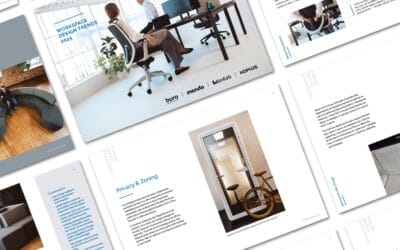Eventually, even a dream job can feel a bit… same-same. Even the most passionate worker can hit a midweek slump or post-lunch fog and start daydreaming about becoming a professional dog walker.
But what if there is a way to keep your team energised, supported, and keen to come into work each day? Turns out, there is!
At Buro, we believe true workplace wellbeing is more than a perk—it’s a necessity. It’s something you can feel. It’s right there in the way your back’s still happy at three p.m. In the way your space encourages connection rather than isolation. And in the way your team wants to be there. Even on a Friday!
Wellbeing should be built into the fabric of the workplace—woven through the chairs we sit in, the way natural light flows through the room, and the way leadership sets the tone from the top and promotes mental health at every turn. Ergonomics, layout, and culture all play a role, and when they’re working in harmony, everyone benefits.
Looking to design a workplace where wellbeing is intentional and built to last? Keep reading.
Why workplace wellbeing is moving beyond add-ons
First of all, let’s acknowledge that perks have their place. Coffee machine that remembers your order? Delightful. An office dog named Steve? Iconic.
But when it comes to genuine, long-term wellbeing, surface-level extras just aren’t enough. Wellness Wednesdays won’t fix poor lighting. Lunchtime Pilates won’t undo hours spent in an unsupportive chair.
More and more organisations are recognising this and shifting their focus. Instead of layering wellbeing on top of a stressful or outdated environment, they’re building it into the foundation.
And it’s not just about doing right by your people (though that certainly matters); it’s a smart business move too. Research shows workplace wellbeing is directly linked to engagement, productivity, and staff retention.
In other words, workspaces designed for wellbeing make people feel good and help them perform well.
How do you design a workplace that promotes wellbeing? Start with your furniture.
When we talk about workplace wellbeing, furniture might not be the first thing that springs to mind. But if you’re spending 40-plus hours a week at a desk, the way that desk—and the chair next to it—is designed has a major impact.
Enter: ergonomics, the science of designing tools, furniture, and spaces that work with the human body, not against it. A well-designed chair supports posture, reduces discomfort, boosts focus, and even lowers absenteeism.
And because no two people work the same way, adjustable features are key. Think: height, tilt, lumbar support, armrests. Furniture that can adapt to the person using it, supporting their spine, moving with their body, and helping them stay energised, not exhausted, throughout the day.
One great example is the Buro Force chair. Designed with both durability and comfort in mind, it’s built to support the people who spend serious time at their desks. With adjustable features, strong lumbar support, and a breathable mesh back, it’s the kind of chair that helps your team stay focused and feel good.
The Buro Force chair
“A very comfortable chair with a nice seat and backrest profiles. It is well-configured, and with an excellent range of adjustments, it will suit many users.”
Next, consider your workplace layout
Once you’ve nailed the basics—ergonomic, adjustable furniture that physically supports your people—the next step is looking at the bigger picture. How does your workplace flow? Where do people move, meet, pause, and connect?
A well-designed office layout is a culture cue. The right layout can encourage collaboration, spark creativity, and help your workplace limit silos and stress.
Wellbeing isn’t just physical—it’s social, too. Breakout zones, shared tables, open-but-not-noisy areas: these are the spaces where ideas are exchanged and relationships are built.
Smart layouts do more than just look polished—they help people feel part of something bigger. When connection is an afterthought, people retreat. Morale dips. Culture takes a hit. But when a workplace makes it easy and natural to interact, community can flourish.
Koplus Kolo Studio Booth for focussed work in an office with a hybrid layout.
Designing for the senses: The details that make a difference
Ever walked into a space and instantly felt calm? Or unexpectedly energised? On the flip side, have you ever struggled to concentrate because of a flickering light or constant background buzz?
Designing for the senses means thinking beyond function, because how a space feels affects how it works. When setting up a workplace, consider:
- Lighting: Natural light has been shown to boost mood, support circadian rhythms, and improve alertness. Aim for bright, consistent lighting that draws in daylight wherever possible.
- Acoustics: A quiet hum is okay. A fridge buzz or echoey hallway? Not so much. The right acoustics improve focus and reduce fatigue.
- Biophilic design: Bringing natural elements indoors (like plants, timber finishes, and earthy textures) can purify the air, soothe the senses, and help regulate the nervous system. Read more about biophilic design here.
- Focused spaces: Minimise distractions with dedicated areas designed for deep concentration. Think booth seating, sound-absorbing materials, and clever spatial zoning. Our Koplus booths are a great example—providing visual and acoustic privacy while still looking sleek and modern.
These thoughtful design choices might seem subtle, but they create an environment where people feel good and thrive.
Workplace wellbeing beyond the desk: Supporting mental health at work
Wellbeing isn’t just about physical comfort—it’s also about how supported people feel. The best workplaces recognise people as humans first, employees second.
Just as comfort is woven into the furniture, mental health support should be woven into workplace culture. That means creating an environment where people feel safe, respected, and able to show up as themselves.
Here are a few ways to support mental wellbeing at work:
- Lead by example: When leadership prioritises mental health and models healthy boundaries, others follow.
- Normalise time off: Clear expectations around leave and flexible hours help protect work-life balance.
- Keep communication open: Encourage honest conversations, regular check-ins, and a culture of psychological safety.
- Design for movement and comfort: When your body feels good—thanks to an ergonomic chair or a layout that encourages movement—your mind becomes clearer, calmer, and more resilient.
Ultimately, the goal is a workplace where people feel seen, supported, and able to bring their full selves to work, while maintaining a healthy work-life balance.

Ready to design wellbeing into your workplace?
From the chairs we sit in to the way a space invites connection, every design choice shapes how people work and how they feel. When you design for people first, everything else follows.
Is it time to create a workplace that supports worker wellbeing from the ground up? Let’s talk.







